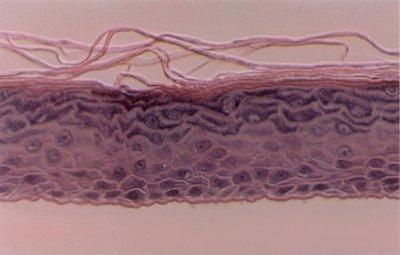The purpose of this test is to evaluate the potential skin corrosivity of the test article by measuring the conversion of 3-[4,5-dimethylthiazol-2-yl]-2,5-diphenyltetrazolium bromide (MTT) to a formazan product by EpiDerm after exposure to the test article(s). The method involves a 3 minute exposure for corrosive and a 1 hour confirmation exposure for a non-corrosive classification that is consistent with the ECVAM prevalidation EpiDerm Skin Corrosivity Test protocol.
The EpiDerm™ model is composed of human keratinocytes stratified into a 3-dimensional dermal structure consisting of basal, spinous, and granular layers, including a functioning stratum corneum with characteristic lipid lamellae.
EpiDerm™ is suited to address the corrosive potential of test materials. Test materials are applied topically at formulation strength. Suited for both water soluble and insoluble formulations. Suitable for testing creams, pastes, highly viscous materials, and powders otherwise precluded from testing in other models. Cells are of human origin.
Experimental procedure: Each culture is removed with sterile forceps from the agarose gel, inspected, and transferred to a pre-labeled 6-well plate containing 0.9 ml of assay medium per well. The EpiDerm cultures will be incubated at 37±1°C in a humidified atmosphere of 5±1% CO2 in air for at least one hour prior to dosing. The positive control is 8N KOH and exposed for 3 and 60minutes. The negative control is sterile, deionized water generally exposed concurrently with the longest exposure time of the test or positive control articles. 50 μl (liquids) or 25 mg (solids) of the test or control article are applied topically onto the tissue surface. The cultures are returned to the incubator for the appropriate exposure times of 3 to 60 minutes. After the appropriate exposure time, the test articles are rinsed from the cultures using DPBS without Ca2+ and Mg2+. The cultures are transferred to wells containing 0.3 ml of MTT reagent (1 mg/ml) and incubated for 3 hours. After incubation, the cultures are blotted on absorbent paper and extracted in 2 ml of isopropanol for 2 hours, while shaking. 200 μl of each extraction solution are transferred to a 96-well plate and the absorbance at 550nm (OD550) recorded.
Data Evaluation: The relative survival is determined by comparing the mean corrected OD550 of the test article-treated wells to the mean corrected OD550 of the negative control-treated wells.
Interpretation: Test materials that reduce tissue viability to < 50% after a 3 minute exposure are classified corrosive. In addition, test materials which result in tissue viability = 50% after a 3 minute exposure and < 15% after a 60 minute exposure are also classified corrosive. Tissue viabilities of = 50% after a 3 minute exposure and = 15% after a 60 minute exposure are classified non-corrosive.
